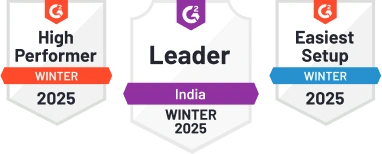Grab a chance to avail 6 Months of Performance Module for FREE
Book a free demo session & learn more about it!
-
Will customized solution for your needs.
-
Empowering users with user-friendly features.
-
Driving success across diverse industries, everywhere.
Grab a chance to avail 6 Months of Performance Module for FREE
Book a free demo session & learn more about it!
Superworks
Modern HR Workplace
Your Partner in the entire Employee Life Cycle
From recruitment to retirement manage every stage of employee lifecycle with ease.



Seamless onboarding & offboarding
Automated compliance & payroll
Track performance & engagement
Field Service Engineer KRA/KPI
- Key Responsibility Areas (KRA) & Key Performance Indicators (KPI) for Field Service Engineer
- 1. Technical Expertise
- 2. Customer Relationship Management
- 3. Timely Service Delivery
- 4. Continuous Learning and Development
- 5. Equipment Maintenance and Inventory Management
- 6. Safety Compliance
- 7. Reporting and Documentation
- 8. Team Collaboration
- 9. Efficiency and Productivity
- 10. Customer Feedback and Improvement
- Real-Time Example of KRA & KPI
- Field Service Engineer Example: Implementing Predictive Maintenance
- Key Takeaways
Key Responsibility Areas (KRA) & Key Performance Indicators (KPI) for Field Service Engineer
1. Technical Expertise
KRA: Demonstrating advanced technical knowledge to troubleshoot and resolve complex field service issues effectively.
Short Description: Technical Troubleshooting and Resolution
- KPI 1: Average time taken to resolve technical issues
- KPI 2: Customer satisfaction rating on technical support provided
- KPI 3: Number of successful technical issue resolutions per month
- KPI 4: Percentage of recurring technical issues
2. Customer Relationship Management
KRA: Building and maintaining strong relationships with customers to ensure customer satisfaction and retention.
Short Description: Customer Satisfaction and Retention
- KPI 1: Net Promoter Score (NPS) of assigned customers
- KPI 2: Customer feedback rating on service interactions
- KPI 3: Number of customer service calls resolved on the first contact
- KPI 4: Customer contract renewal rate
3. Timely Service Delivery
KRA: Ensuring prompt and punctual delivery of field service support as per service level agreements (SLAs).
Short Description: Timely Service Support
- KPI 1: Percentage of service requests resolved within SLA timeframe
- KPI 2: Average response time to service requests
- KPI 3: Service downtime reduction percentage
- KPI 4: On-time arrival rate for service appointments
4. Continuous Learning and Development
KRA: Actively engaging in training and upskilling to stay updated with new technologies and industry trends.
Short Description: Professional Development
- KPI 1: Number of training hours completed per quarter
- KPI 2: Certification achievement rate in relevant technologies
- KPI 3: Application of new skills in field service tasks
- KPI 4: Feedback from peers and supervisors on skill improvement
5. Equipment Maintenance and Inventory Management
KRA: Ensuring proper maintenance of tools and equipment used in field service operations and managing inventory efficiently.
Short Description: Equipment Maintenance and Inventory Control
- KPI 1: Equipment downtime percentage due to maintenance issues
- KPI 2: Inventory turnover rate for spare parts and consumables
- KPI 3: Accuracy of equipment maintenance logs and records
- KPI 4: Cost savings achieved through effective inventory management
6. Safety Compliance
KRA: Adhering to safety protocols and regulations to ensure a safe working environment for oneself and others.
Short Description: Workplace Safety
- KPI 1: Number of safety incidents reported or recorded
- KPI 2: Safety training completion rate among the team
- KPI 3: Compliance with safety audit requirements
- KPI 4: Days without any safety violations or incidents
7. Reporting and Documentation
KRA: Maintaining accurate documentation of service activities, reports, and feedback for analysis and improvement.
Short Description: Documentation Accuracy and Analysis
- KPI 1: Timeliness of service reports submission
- KPI 2: Accuracy of service logs and documentation
- KPI 3: Utilization of documented data for service improvement initiatives
- KPI 4: Feedback from supervisors on report quality and insights
8. Team Collaboration
KRA: Collaborating effectively with team members and other departments to deliver seamless field service support.
Short Description: Cross-functional Collaboration
- KPI 1: Participation in team meetings and knowledge sharing sessions
- KPI 2: Feedback from colleagues on teamwork and support
- KPI 3: Successful resolution rate of escalated service issues through collaboration
- KPI 4: Contribution to team performance and morale
9. Efficiency and Productivity
KRA: Increasing efficiency and productivity in field service operations through optimized processes and resource utilization.
Short Description: Operational Efficiency
- KPI 1: Service response time improvement percentage
- KPI 2: Utilization rate of field service resources (vehicles, tools, etc.)
- KPI 3: Number of service tasks completed per day/week/month
- KPI 4: Cost reduction achieved through process improvements
10. Customer Feedback and Improvement
KRA: Collecting and analyzing customer feedback to identify areas for service improvement and implementing corrective actions.
Short Description: Customer Feedback Analysis and Implementation
- KPI 1: Number of customer feedback surveys conducted
- KPI 2: Implementation rate of customer suggestions for service enhancement
- KPI 3: Improvement in customer satisfaction scores post-feedback implementation
- KPI 4: Reduction in customer complaints and escalations
Real-Time Example of KRA & KPI
Field Service Engineer Example: Implementing Predictive Maintenance
KRA: Implementing predictive maintenance strategies to reduce equipment downtime and improve service efficiency.
- KPI 1: Percentage increase in equipment uptime after predictive maintenance implementation
- KPI 2: Cost savings achieved through proactive equipment maintenance
- KPI 3: Feedback from customers on improved service reliability
- KPI 4: Reduction in emergency service calls due to predictive maintenance
Describe how these KPIs led to improved performance and success.
Key Takeaways
- KRA defines what needs to be done, whereas KPI measures how well it is done.
- KPIs should always be SMART (Specific, Measurable, Achievable, Relevant, Time-bound).
- Regular tracking and adjustments ensure success in Field Service Engineer.




